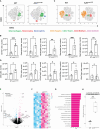Myeloid A20 is critical for alternative macrophage polarization and type-2 immune-mediated helminth resistance
- PMID: 38680500
- PMCID: PMC11045979
- DOI: 10.3389/fimmu.2024.1373745
Myeloid A20 is critical for alternative macrophage polarization and type-2 immune-mediated helminth resistance
Abstract
Background: Protective immunity against intestinal helminths requires induction of robust type-2 immunity orchestrated by various cellular and soluble effectors which promote goblet cell hyperplasia, mucus production, epithelial proliferation, and smooth muscle contractions to expel worms and re-establish immune homeostasis. Conversely, defects in type-2 immunity result in ineffective helminth clearance, persistent infection, and inflammation. Macrophages are highly plastic cells that acquire an alternatively activated state during helminth infection, but they were previously shown to be dispensable for resistance to Trichuris muris infection.
Methods: We use the in vivo mouse model A20myel-KO, characterized by the deletion of the potent anti-inflammatory factor A20 (TNFAIP3) specifically in the myeloid cells, the excessive type-1 cytokine production, and the development of spontaneous arthritis. We infect A20myel-KO mice with the gastrointestinal helminth Trichuris muris and we analyzed the innate and adaptive responses. We performed RNA sequencing on sorted myeloid cells to investigate the role of A20 on macrophage polarization and type-2 immunity. Moreover, we assess in A20myel-KO mice the pharmacological inhibition of type-1 cytokine pathways on helminth clearance and the infection with Salmonella typhimurium.
Results: We show that proper macrophage polarization is essential for helminth clearance, and we identify A20 as an essential myeloid factor for the induction of type-2 immune responses against Trichuris muris. A20myel-KO mice are characterized by persistent Trichuris muris infection and intestinal inflammation. Myeloid A20 deficiency induces strong classical macrophage polarization which impedes anti-helminth type-2 immune activation; however, it promotes detrimental Th1/Th17 responses. Antibody-mediated neutralization of the type-1 cytokines IFN-γ, IL-18, and IL-12 prevents myeloid-orchestrated Th1 polarization and re-establishes type-2-mediated protective immunity against T. muris in A20myel-KO mice. In contrast, the strong Th1-biased immunity in A20myel-KO mice offers protection against Salmonella typhimurium infection.
Conclusions: We hereby identify A20 as a critical myeloid factor for correct macrophage polarization and appropriate adaptive mucosal immunity in response to helminth and enteric bacterial infection.
Keywords: A20 (TNFAIP3); adaptive immunity; helminth infection; immunity to parasites; innate immunity; intestinal immunity; macrophage polarization; type-2 response.
Copyright © 2024 Petta, Thorp, Ciers, Blancke, Boon, Meese, Van Nieuwerburgh, Wullaert, Grencis, Elewaut, van Loo and Vereecke.
Conflict of interest statement
Author LB is employed by the company JJP Biologics. The remaining authors declare that the research was conducted in the absence of any commercial or financial relationships that could be construed as a potential conflict of interest.
Figures







Similar articles
-
Arginase-1-expressing macrophages are dispensable for resistance to infection with the gastrointestinal helminth Trichuris muris.Parasite Immunol. 2011 Jul;33(7):411-20. doi: 10.1111/j.1365-3024.2011.01300.x. Parasite Immunol. 2011. PMID: 21585399 Free PMC article.
-
Characterisation of the protective immune response following subcutaneous vaccination of susceptible mice against Trichuris muris.Int J Parasitol. 2010 May;40(6):683-93. doi: 10.1016/j.ijpara.2009.11.008. Epub 2009 Dec 5. Int J Parasitol. 2010. PMID: 19968992 Free PMC article.
-
The Essential Role Played by B Cells in Supporting Protective Immunity Against Trichuris muris Infection Is by Controlling the Th1/Th2 Balance in the Mesenteric Lymph Nodes and Depends on Host Genetic Background.Front Immunol. 2019 Dec 10;10:2842. doi: 10.3389/fimmu.2019.02842. eCollection 2019. Front Immunol. 2019. PMID: 31921120 Free PMC article.
-
Cytokine-mediated regulation of intestinal helminth infections: the Trichuris muris model.Ann Trop Med Parasitol. 1993 Dec;87(6):643-7. doi: 10.1080/00034983.1993.11812823. Ann Trop Med Parasitol. 1993. PMID: 8122927 Review.
-
The Trichuris muris system: a paradigm of resistance and susceptibility to intestinal nematode infection.Adv Parasitol. 2004;57:255-307. doi: 10.1016/S0065-308X(04)57004-5. Adv Parasitol. 2004. PMID: 15504540 Review.
Cited by
-
Macrophage plasticity: signaling pathways, tissue repair, and regeneration.MedComm (2020). 2024 Aug 1;5(8):e658. doi: 10.1002/mco2.658. eCollection 2024 Aug. MedComm (2020). 2024. PMID: 39092292 Free PMC article. Review.
-
Immunomodulation by helminthic parasites and worm therapy.Trop Parasitol. 2025 Jan-Jun;15(1):2-7. doi: 10.4103/tp.tp_5_25. Epub 2025 Apr 5. Trop Parasitol. 2025. PMID: 40433639 Free PMC article. Review.
References
-
- WHO . Investing to overcome the global impact of neglected tropical diseases: third WHO report on neglected diseases. (2015) Geneva, Switzerland: WHO Press, World Health Organization.
Publication types
MeSH terms
Substances
LinkOut - more resources
Full Text Sources
Molecular Biology Databases
Research Materials
Miscellaneous

